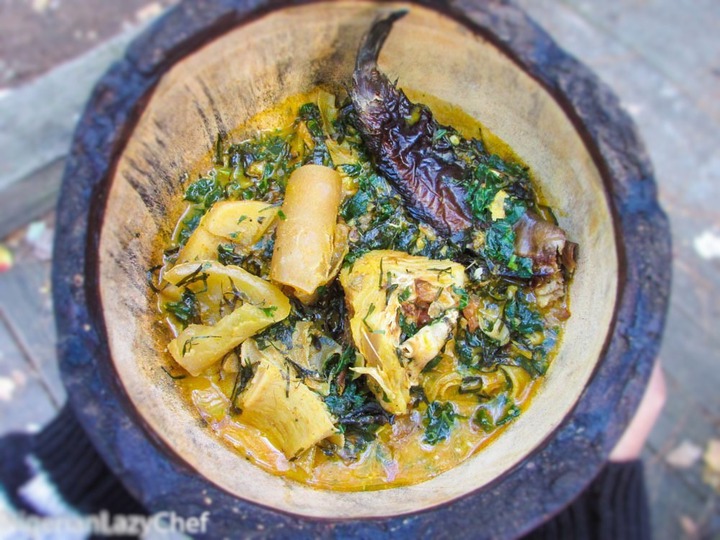The one and only Ofe (Owerri) Owere. This soup has caused so many arguments between cooks. A lot of people have tried to make it and ended up with ofe Uziza, Ofe Achi, or ofe Ede’ i.e. cocoyam soup.
Traditionally, Ofe Owere has two basic vegetables: Ugu i.e. Pumpkin leaves and Okazi. Do your research. Go home and ask our mothers; adding Uziza is a borrowed thing(Alien). Uziza goes well with practically every soup though, but it is not a basic Ofe Owere ingredient. When Oha is added, that’s Ofe Oha. If an’ara leaves are added, that is Ofe an’ara. However sometimes people add all sorts of vegetables based on their own taste, choice and availability. But those vegetables should not be linked to the traditional Ofe Owere. It’s like telling an Efik person that EdikangIkong is cooked with Oha leaves just because you added it to yours and it tasted nice.
The traditional Ofe Owere consists mainly of chuncks of stockfish(Okporoko) and Azu Okpo(dried fish). Snails and other assorted meat add to the beauty and richness of the soup depending on your pocket. Periwinkles(Isam) is actually not an Owere thing, it is added just for ‘effizy'(swag).
Ingredients
2lbs assorted Meats or Goat Meat. (Long throat won’t allow us cook without adding ‘animals’)
(Snails if you choose but its optional)
3- 4 pieces of Stockfish chunks and stock fish head – Basic
2 – 3 pieces of Dry Fish (Azu nkurkunku or Azu Asa)- Basic
1 cup of dry grounded Crayfish – Basic (divided)
2 tablespoons Ose Ikpo (Dry grinded pepper or chili flakes) – Basic (I prefer the dry Cameroon pepper)
1 big bunch Ugu leaves – sliced Basic. Ugu i.e pumpkin leaves is the main vegetable here (In situations where Ugu cannot be found, Kale can be substituted)
1 small bunch Uziza leaves (sliced) Optional
1 small bunch Okazi leaves (thinly sliced) Basic
6-7 pieces of Ede (cocoyam). You can substitute this with Achi – a very popular soup thickening agent. You may not have the time to go through the stress of preparing the cocoyam paste for soup when Achi can suffice but Cocoyam is the Real Deal in Ofe Owere.
1 wrap of Ogiri – Locust beans (optional)
2 cooking spoons of Palm Oil
Salt
bouillon
Cooking instructions
Season the meats and stockfish with salt, half cup of the crayfish, 1 tablespoon of dry pepper. Add some snails (if using) . Don’t forget the stockfish head because that is where you get the real stockfish flavor. Pour water to the level of the meats and cook until tender
How to make the cocoyam paste
Wash the Cocoyam thoroughly and boil with the skin on in lots of water for 10 –15 minutes
When cooked, peel off the skin and pound into a paste. The cocoyam is usually sticky so add a tablespoonful of palm oil. This does 2 things: it keeps the cocoyam from sticking to the mortar and also it enhances the color of the soup.
Once the meat and stockfish have softened, taste the stock and make any necessary adjustments to the flavor.
At this stage, add the cocoyam paste in small portions with your cooking spoon or simply mix the ground ‘Achi’ powder with some water in a bowl, stir well and pour into the soup. Reduce the heat and watch the soup thicken. Stir thoroughly to ensure all cocoyam lumps dissolve totally into the soup. The soup could be runny or thick. Or it could be just in-between. Your choice.
Add the palm oil and washed chunks of dry fish to the soup. (We are adding the dry fish at this stage to prevent it from dissolving in the soup) Part of the thrill is to pick pieces of fish from the soup while eating. Cover the pot and let the soup cook until the oil combines with the soup and looses that raw taste (this takes about 2-5 minutes)
Stir often if you are using Achi because the Achi may settle at the bottom of the pot and cause the soup to start burning.
Add the ogiri, the remaining crayfish and dry pepper and stir thoroughly.
Thoroughly wash the vegetables with cold water. Wash twice or thrice to remove any traces of dust or sand. (it is advisable prefer to wash veggies before they are sliced. That way, vital nutrients won’t be rinsed off. But okazi is basically washed after slicing)
Stir after adding the vegetables and allow to simmer on low heat for an extra 5 minutes then turn off the heat.
Serve with your choice of ‘swallow’ i.e. fufu, pounded yam, plantain flour or eba.
Happy cooking
Notes
When using Achi, use sparingly as it can really thicken the soup
Od9jastyles ( Food
Recipe )
See More

















